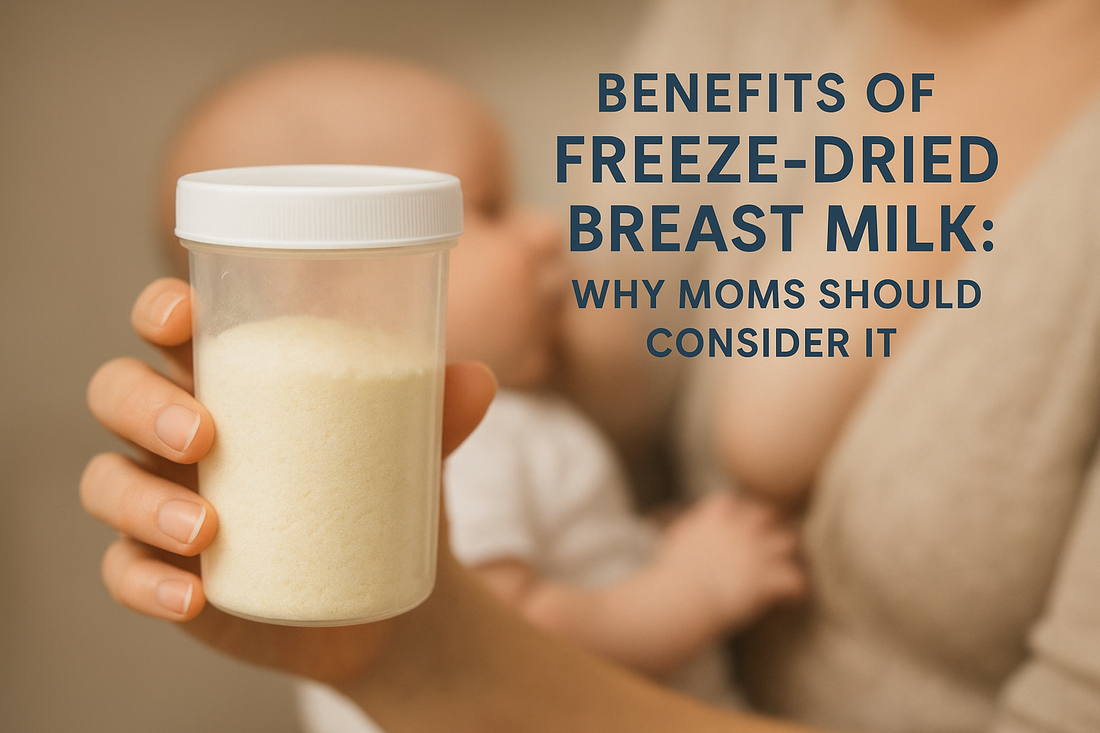
Benefits of Freeze-Dried Breast Milk: Why Moms Should Consider It
Share
Breast milk is the gold standard of infant nutrition, providing essential nutrients, antibodies, and bioactive components that support your baby’s growth and immunity. While fresh or frozen milk has been the traditional option, freeze-dried breast milk has emerged as a convenient and effective alternative for modern moms.
This guide explores the benefits of freeze-dried breast milk, including the freeze-drying process, nutrient retention, milk preservation, and travel-friendly milk options for busy parents.
What is Freeze-Dried Breast Milk?
Freeze-dried breast milk, also known as powdered breast milk, is milk that has undergone a specialized dehydration process. Water content is removed under low temperatures, leaving behind a nutrient-rich powder. This innovative technique ensures the milk retains most of its natural benefits while making storage and transport much easier.
For those interested, you can find premium options like freeze-dried breast milk powder that are safe, reliable, and convenient for everyday use.
The Freeze-Drying Process
The freeze-drying process is a highly specialized method designed to preserve the quality, nutrients, and bioactive components of breast milk while converting it into a stable, long-lasting powder. The process involves several crucial steps:
1. Freezing the Milk
Freshly expressed breast milk is first rapidly frozen. Freezing stabilizes the milk’s structure and prevents the growth of bacteria. Quick freezing also helps maintain the integrity of delicate nutrients, enzymes, and antibodies, ensuring that the milk remains as close as possible to its fresh form.
2. Vacuum Dehydration
Once frozen, the milk undergoes vacuum dehydration. In this stage, the milk is placed in a low-pressure chamber where water is removed through a process called sublimation, which converts ice directly into vapor without passing through a liquid phase. This gentle method avoids heat exposure, which could degrade sensitive proteins and vitamins.
3. Sealed Packaging
After dehydration, the resulting powdered milk is immediately packaged in airtight, moisture-proof containers. This prevents contamination, preserves the powder’s freshness, and ensures a long shelf life. Some products also include oxygen absorbers to further enhance stability.
4. Nutrient Preservation
Unlike traditional high-heat drying or pasteurization, freeze-drying maintains most of the milk’s nutrients, antibodies, and enzymes. This means that when the milk is rehydrated, it retains its nutritional and immunological benefits, supporting your baby’s growth and immune system effectively.
Key Benefits of Freeze-Dried Breast Milk
1. Extended Shelf Life and Milk Preservation
Freeze-dried milk can last months or even years when stored in a cool, dry place. This reduces waste and allows moms to build a milk reserve without worrying about spoilage. For more details on traditional storage, see breast milk storage.
2. Nutrient Retention
Unlike high-heat pasteurization or extended freezer storage, freeze-drying preserves most vitamins, minerals, and bioactive compounds. This ensures your baby receives milk that is as close to fresh as possible in terms of nutritional value.
3. Travel-Friendly Milk
Powdered milk is lightweight, easy to pack, and does not require refrigeration until rehydrated. It is perfect for vacations, work trips, or emergencies when fresh or frozen milk isn’t feasible. Learn more about milk handling during travel in how long can breast milk last outside.
4. Convenience for Busy Moms
Freeze-dried milk allows moms to store milk in small, manageable portions. Rehydrating it with warm water is simple, providing quick and safe feeding without thawing bottles.
5. Safe Alternative During Milk Shortages
For moms who occasionally face low milk supply, freeze-dried breast milk offers a safe, nutrient-rich alternative that can supplement feedings. Tips to increase milk supply can be found in how to increase breast milk supply.
6. Easy Portion Control
Powdered milk can be measured precisely, making it easy to prepare the exact amount your baby needs. This minimizes waste and ensures consistent feeding.
7. Reduced Freezer Space Needs
Unlike frozen milk, powdered milk doesn’t require freezer storage. This is especially helpful for families with limited freezer capacity, or for storing milk long-term.
How to Use Freeze-Dried Breast Milk
-
Measure the Powder – Use the recommended amount based on your baby’s age and feeding schedule.
-
Add Warm Water – Rehydrate the milk with clean, lukewarm water.
-
Mix Gently – Swirl to combine; avoid vigorous shaking to preserve milk properties.
-
Feed Immediately or Store Briefly – Once rehydrated, use the milk within 2 hours, or refrigerate for short-term use.
Additional tips for handling milk safely can be found in milk temperature for baby.
Conclusion
Freeze-dried breast milk offers a revolutionary solution for modern parents, combining the benefits of fresh milk with convenience, longevity, and portability. Its nutrient retention, milk preservation, and travel-friendly nature make it a reliable choice for busy moms. By understanding the freeze-drying process and proper handling techniques, you can provide your baby with safe, nutritious milk anytime, anywhere.
Whether for long-term storage, travel, or supplementing feedings, freeze-dried breast milk powder is a smart, convenient, and healthy option for families.
Frequently Asked Questions
Is freeze-dried breast milk safe for all babies?
Yes, it retains essential nutrients and is safe for infants when prepared according to instructions.
How long can freeze-dried milk last?
When stored in airtight packaging in a cool, dry place, it can last months or even years.
Can freeze-dried milk replace frozen milk entirely?
It can supplement or replace frozen milk in many situations, especially for travel and emergencies.
Does freeze-drying reduce antibodies in milk?
Most antibodies and bioactive components are preserved, although a small percentage may be affected.
How do I rehydrate freeze-dried milk?
Use clean, lukewarm water and mix gently to maintain milk quality.
Can I travel with freeze-dried milk?
Yes, it is highly travel-friendly and doesn’t require refrigeration until mixed.
Does it taste different from fresh milk?
Some babies may notice a slight difference, but most accept it easily.
Can I freeze rehydrated milk?
No, once rehydrated, milk should be used within 2 hours or refrigerated briefly.
Is it more expensive than frozen milk?
Freeze-dried milk may cost more due to processing, but the convenience and shelf life often outweigh the cost.
Can freeze-dried milk be used for older infants?
Yes, it can be used for infants of all ages, including toddlers who benefit from breast milk’s nutrients.
